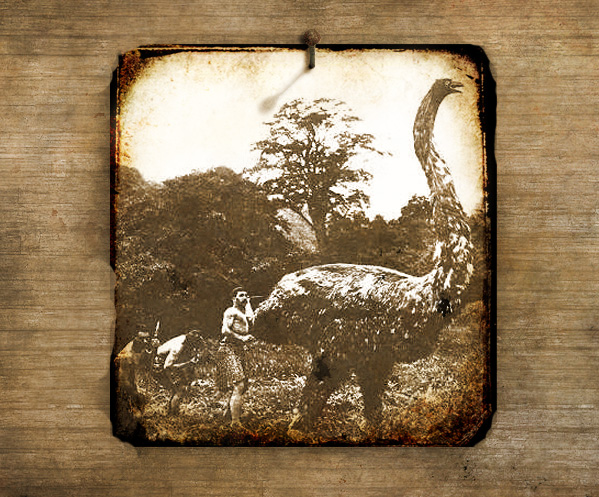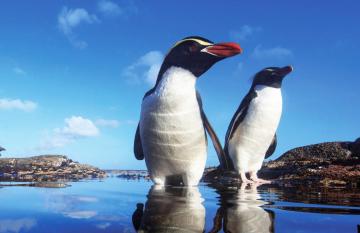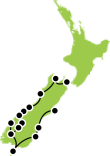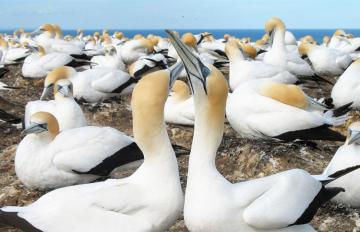
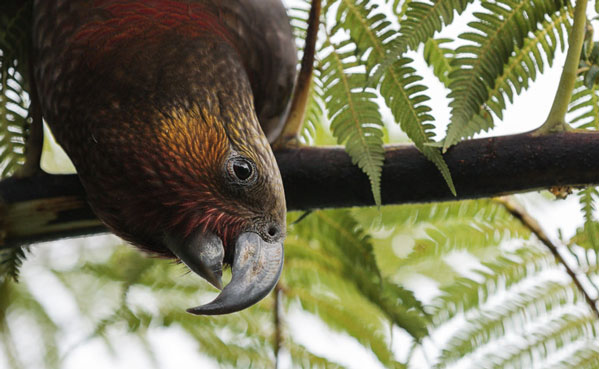
When humans first arrived in New Zealand, no more than 900 years ago, birdsong and surf would have been the first noise they heard as they approached the lush forested islands - the land was almost exclusively populated by birds that make up the bulk of New Zealand wildlife. New Zealand's 80 million years of isolation, since breaking away from the super-continent of Gondwanaland, has allowed the evolution of nearly 200 species of birds and due to the absence of mammalian predators a high proportion of them were flightless – some of them grew into Giants - but what birds they are!
Want to see New Zealand's wildlife close up? Then take a look at our Self Drive Nature and Wildlife Tours.
Big Bird...
New Zealand's 80 million years of isolation, since breaking away from the super-continent of Gondwanaland, has allowed the evolution of nearly 200 species of birds and due to the absence of mammalian predators a high proportion of them were flightless – some of them grew into Giants... Large size was an advantage as the only predators were other birds. Consequently, many giant species developed, most notably the three-metre high ostrich-like moa (the Polynesian word for chicken), the average moa caught by Māori weighed around 75 kilos (165 Pounds), half of which was edible and understandably hunted to extinction in pre-European times. Other giants included Haast's eagle (the world's largest eagle), and a giant penguin nearly as large as a human – also now extinct.
Flightless Birds
The Kiwi
Our Best known among them is the kiwi, the national symbol, a nocturnal ground-dweller with a long and slender bill, and a large, round body covered in hair-like plumage and vestigial wings (think chicken with a big nose). While shy and difficult to find in the wild, its piercing call "ki-wi" can be heard at night in the more remote regions. Other flightless birds include the kakapo and takahe. The blue-green kakapo is the world's largest parrot, but only fifty birds survive in a wilderness refuge in Fiordland. Likewise, the takahe is another very endangered big, ponderous bird of brilliant plumage which only survives in remote Fiordland. 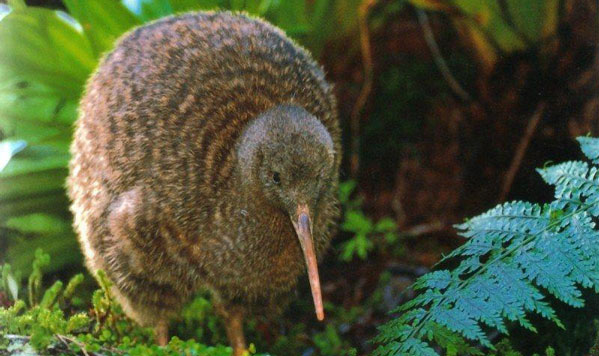
The Weka
The weka is another flightless bird common to the West Coast forests of the South Island. It is a large, inquisitive, brown rail, ever ready to snap up unguarded objects, particularly if they are bright and shiny. Another notorious thief is the kea, a brown-green parrot with scarlet underwings which lives in mountainous regions of the South Island. With its cheeky disregard for humans and powerful beak, this adaptable scavenger can cause significant damage to virtually anything it sets its determined sights on. Most visitors to the alpine regions of the South Island will encounter keas and they should try to keep temptation out of harm's way! 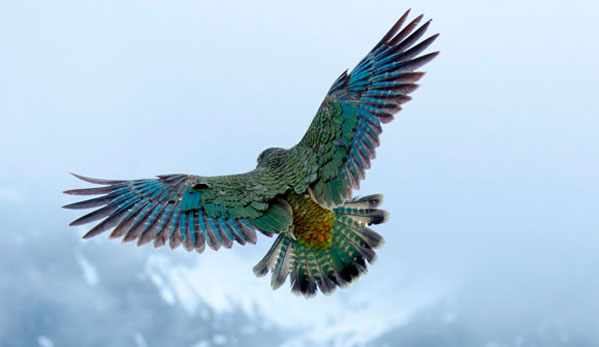
The Kaka
The shy kaka is a brown-green forest parrot similar in size and colouring to a kea but with a distinctive crimson rump and abdomen. It is found exclusively in native bush on island refuges off the North Island and throughout the South Island. (the first picture in the post)
Other New Zealand Wildlife that Star in our Forests
The Tui
The tui, or parson bird, is a beautiful metallic bluish-purple songbird which is found mainly in native bush habitats. It has a distinctive throat tuft of white curled feathers from which the name "parson bird" derives and is an accomplished linguist. Maori villages often featured talking tuis. Another songbird, the olive-green bellbird, or korimako, is common throughout the country. 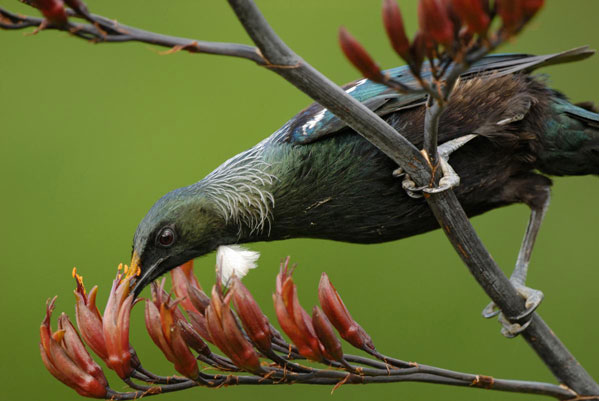
The Other Usual Suspects
The fearless fantail is a pied or brown flycatcher that frequently accompanies trampers in the bush, flitting around catching insects that have been disturbed by the passage of people through the undergrowth. Also frequently heard, if not seen, in the bush, is the soft swoosh of wings as the kereru, or wood pigeon, flies through the forest. Greyish-white with a green head and a large, plump body, the kereru was extensively hunted during early European settlement. Dwindling numbers led to its protection and it has rapidly re-established itself throughout the country. Frequently seen in marshland, are the pukeko and the graceful kotuku. The blue-black pukeko with its white underwing, scarlet bill, and frontal plate, is a large rail that is completely unafraid of humans. With their broad, splayed feet they walk across floating reed-clumps, seemingly walking on water, so they are often referred to as "Jesus birds". The beautiful kotuku, or white heron, was prized by the Maori for its plumage. Ceremonial head-dress and ornaments were made from the brilliant white feathers. 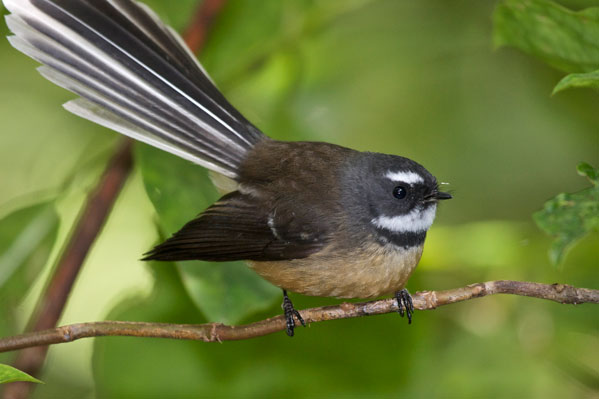 New Zealand has 87 species of seabirds of which 20 percent are endemic. Coastal rookeries teem with life; species include oyster catchers, dotterels, shearwaters, petrels, shags, and gannets.
New Zealand has 87 species of seabirds of which 20 percent are endemic. Coastal rookeries teem with life; species include oyster catchers, dotterels, shearwaters, petrels, shags, and gannets.
Here at first Light Travel we run our own tours that get you up-close and personal with some of the extraordinary New Zealand wildlife featured in this article and many more. Whether it be one of our set departure 'Easy Going World Heritage Hiking Tours' or perhaps an individually crafted New Zealand self-drive tour.
Recent Posts
Blog Categories
Blog archives
- April 2025 (2)
- February 2025 (3)
- January 2025 (6)
- December 2024 (12)
- November 2024 (3)
- October 2024 (2)
- July 2024 (2)
- May 2024 (12)
- April 2024 (2)
- March 2024 (2)
- January 2024 (2)
- November 2023 (10)
- October 2023 (4)
- August 2023 (1)
- May 2023 (2)
- April 2023 (2)
- March 2023 (17)
- February 2023 (4)
- January 2023 (4)
- December 2022 (11)
- November 2022 (7)
- October 2022 (1)
- May 2022 (1)
- March 2022 (3)
- February 2022 (3)
- January 2022 (1)
- December 2021 (1)
- August 2021 (1)
- June 2021 (1)
- May 2021 (2)
- February 2021 (1)
- August 2020 (1)
- July 2020 (1)
- May 2020 (1)
- April 2020 (1)
- March 2020 (1)
- January 2020 (1)
- December 2019 (1)
- November 2019 (1)
- October 2019 (1)
- September 2019 (1)
- August 2019 (5)
- July 2019 (2)
- June 2019 (1)
- May 2019 (3)
- April 2019 (1)
- March 2019 (1)
- February 2019 (1)
- January 2019 (1)
- December 2018 (1)
- November 2018 (1)
- September 2018 (1)
- August 2018 (1)
- July 2018 (1)
- June 2018 (1)
- May 2018 (1)
- April 2018 (1)
- March 2018 (1)
- February 2018 (1)
- January 2018 (1)
- December 2017 (1)
- October 2017 (1)
- September 2017 (1)
- August 2017 (1)
- July 2017 (1)
- June 2017 (1)
- May 2017 (1)
- April 2017 (1)
- March 2017 (1)
- February 2017 (1)
- January 2017 (1)
- December 2016 (1)
- November 2016 (1)
- October 2016 (1)
- September 2016 (1)
- August 2016 (1)
- July 2016 (1)
- June 2016 (1)
- May 2016 (1)
- April 2016 (1)
- March 2016 (1)
- February 2016 (1)
- January 2016 (1)
- December 2015 (1)
- November 2015 (1)
- October 2015 (1)
- September 2015 (1)
- August 2015 (1)
- July 2015 (1)
- June 2015 (1)
- May 2015 (1)
- April 2015 (1)
- March 2015 (1)
- February 2015 (1)
- January 2015 (1)
- December 2014 (1)
- November 2014 (1)
- October 2014 (1)
- September 2014 (1)
- July 2014 (1)
- June 2014 (3)
- May 2014 (1)
- April 2014 (1)
- March 2014 (1)
- February 2014 (1)
- January 2014 (1)
- November 2013 (15)
- October 2013 (1)
- September 2013 (1)
- August 2013 (1)
- July 2013 (1)
- May 2013 (1)
- April 2013 (1)
- March 2013 (1)
- February 2013 (1)
- January 2013 (1)
- December 2012 (1)
- November 2012 (2)
- October 2012 (2)
- September 2012 (2)
- August 2012 (2)
- July 2012 (2)
- June 2012 (2)
- May 2012 (2)
- April 2012 (3)
- March 2012 (2)
- February 2012 (2)
- January 2012 (2)
- December 2011 (2)
- November 2011 (1)
- October 2011 (2)
- September 2011 (1)
- August 2011 (1)
- July 2011 (1)
- June 2011 (1)
- May 2011 (1)
- April 2011 (1)
- March 2011 (1)
- February 2011 (1)
- January 2011 (1)
- December 2010 (1)
- November 2010 (1)
- October 2010 (1)
- September 2010 (1)
- August 2010 (1)
- July 2010 (1)
- June 2010 (1)
- May 2010 (1)
- March 2010 (1)
- February 2010 (1)
- January 2010 (1)
- December 2009 (1)
- November 2009 (1)
- October 2009 (1)
- September 2009 (1)
- August 2009 (1)
- July 2009 (1)
- June 2009 (1)
- May 2009 (1)
- April 2009 (1)
- March 2009 (1)
- February 2009 (1)
- January 2009 (1)
- December 2008 (1)
- May 2005 (1)


